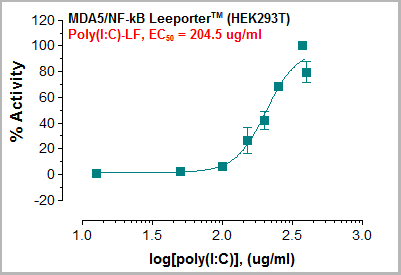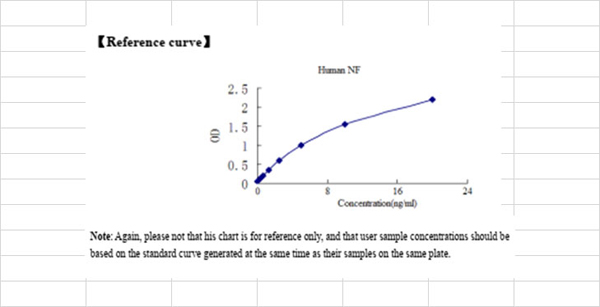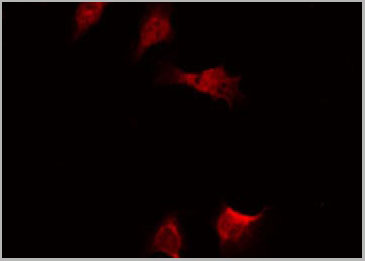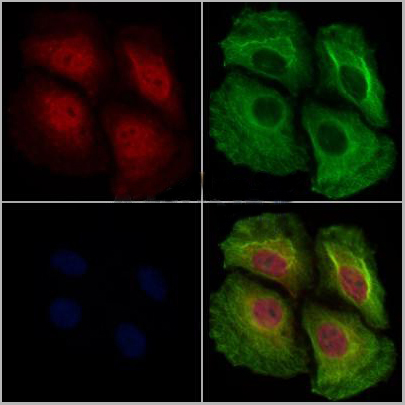Applicable Applications for MDA5/NF-kBT cell line
FA (Functional Assay)
Application Notes
Monitor the MDA5 signaling pathway activity.
Screen for activators or inhibitors of the MDA5 signaling pathway.
Screen for activators or inhibitors of the MDA5 signaling pathway.
Content
Each vial contains 2 ~ 3 x 10^6 cells in 1 ml of 90% FBS + 10% DMSO.
Culture conditions
Cells should be grown at 37 degree C with 5% CO2 using DMEM medium (w/ L-Glutamine, 4.5g/L Glucose and Sodium Pyruvate) supplemented with 10% heat-inactivated FBS and 1% Pen/Strep, plus 2 ug/ml of Puromycin and 5 ug/ml Blasticidin (Note: Puromycin and Blasticidin can be omitted during the reporter cell assays).
It is recommended to quickly thaw the frozen cells upon receipt or from liquid nitrogen in a 37 degree C water-bath, transfer to atube containing 10 ml of growth medium without Puromycin and Blasticidin, spin down cells, resuspend cells in prewarmed growth medium without Puromycin and Blasticidin, transfer resuspended cells to T25 flask and culture in 37 degree C CO2 incubator.
Leave the T25 flask in the incubator for 1~3 days without disturbing or changing the medium until cells completely recover viability and become adherent. Once cells are over 90% adherent, remove growth medium and passage the cells through trypsinization and centrifugation. At first passage, switch to growth medium containing Puromycin and Blasticidin. Cells should be split before they reach complete confluence.
To passage the cells, detach cells from culture vessel with Trypsin/EDTA, add complete growth medium and transfer to a tube, spin down cells, resuspend cells and seed appropriate aliquots of cells suspension into new culture vessels. Subcultivation ration = 1:10 to 1:20 weekly. To achieve satisfactory results, cells should not be passaged over 16 times.
It is recommended to quickly thaw the frozen cells upon receipt or from liquid nitrogen in a 37 degree C water-bath, transfer to atube containing 10 ml of growth medium without Puromycin and Blasticidin, spin down cells, resuspend cells in prewarmed growth medium without Puromycin and Blasticidin, transfer resuspended cells to T25 flask and culture in 37 degree C CO2 incubator.
Leave the T25 flask in the incubator for 1~3 days without disturbing or changing the medium until cells completely recover viability and become adherent. Once cells are over 90% adherent, remove growth medium and passage the cells through trypsinization and centrifugation. At first passage, switch to growth medium containing Puromycin and Blasticidin. Cells should be split before they reach complete confluence.
To passage the cells, detach cells from culture vessel with Trypsin/EDTA, add complete growth medium and transfer to a tube, spin down cells, resuspend cells and seed appropriate aliquots of cells suspension into new culture vessels. Subcultivation ration = 1:10 to 1:20 weekly. To achieve satisfactory results, cells should not be passaged over 16 times.
Functional validation
A. Response of MDA5 Leeporter™ – HEK293T cells to Poly(I:C).
1. Harvest MDA5 Leeporter™ – HEK293T cells and seed cells into a white solid-bottom 96-well microplate in 100 ul of growth medium at 5 x 104 cells/well.
2. Incubate cells at 37 degree C in a CO2 incubator for overnight.
3. The next day, stimulate cells with various concentrations of the poly(I:C) packed with lipofectamine 2000, which was prepared as follows:
i) A 50 ul of 10 mg/ml poly(I:C) (= 500 ug total) is preincubated in 50 ul Opti-MEM (Life Technologies) for 5 min.
ii) Similarly, a 20 ul Lipofectamine 2000 (Life Technologies) is preincubated in 80 ul Opti-MEM for 5 min.
iii) After 5 min, they are combined together as a total volume of 200 ul and further incubated for 20 min at room temperature.
iv) The poly(I:C) packed with Lipofectamine 2000 (A 200 ul total at 2.5 mg/ml) is then used to stimulate cells.
4. Incubate at 37 degree C in a CO2 incubator for 16 hours.
5. Equilibrate the plate to room temperature for 10 minutes.
6. Add 50 ul of luciferase assay reagent (Cat # Refer to the reagent datasheet for the detailed luciferase assay protocol) per well.
7. Read the plate in 1-5 minutes to measure luminescence using a microplate luminometer.
1. Harvest MDA5 Leeporter™ – HEK293T cells and seed cells into a white solid-bottom 96-well microplate in 100 ul of growth medium at 5 x 104 cells/well.
2. Incubate cells at 37 degree C in a CO2 incubator for overnight.
3. The next day, stimulate cells with various concentrations of the poly(I:C) packed with lipofectamine 2000, which was prepared as follows:
i) A 50 ul of 10 mg/ml poly(I:C) (= 500 ug total) is preincubated in 50 ul Opti-MEM (Life Technologies) for 5 min.
ii) Similarly, a 20 ul Lipofectamine 2000 (Life Technologies) is preincubated in 80 ul Opti-MEM for 5 min.
iii) After 5 min, they are combined together as a total volume of 200 ul and further incubated for 20 min at room temperature.
iv) The poly(I:C) packed with Lipofectamine 2000 (A 200 ul total at 2.5 mg/ml) is then used to stimulate cells.
4. Incubate at 37 degree C in a CO2 incubator for 16 hours.
5. Equilibrate the plate to room temperature for 10 minutes.
6. Add 50 ul of luciferase assay reagent (Cat # Refer to the reagent datasheet for the detailed luciferase assay protocol) per well.
7. Read the plate in 1-5 minutes to measure luminescence using a microplate luminometer.
Preparation and Storage
Immediately upon receipt, store in liquid nitrogen.
Related Product Information for MDA5/NF-kBT cell line
The MDA5 Leeporter™ Luciferase Reporter cell line is a stably transfected HEK 293T cell line which expresses human melanoma differentiation-associated protein-5 (MDA5) and Renilla luciferase reporter gene under the transcriptional control of an NF-kB response element. As a dsRNA helicase enzyme, MDA5 is encoded by the IFIH1 gene. MDA5 is one of the RIG-I-like receptors (RLRs) that are a family of DExD/H box RNA helicases including MDA5, RIG-I and LPG2, which play a major role in pathogen sensing of RNA virus infection to initiate and modulate antiviral immunity. RLR expression is typically maintained at low levels in resting cells but is greatly increased during inflammation, specifically with IFN exposure and after virus infection. MDA5 detects cytoplasmic dsRNA generated during viral replication unlike Toll-like receptor 3 (TLR3) which can detect phagocytosed dsRNA in endosomes. MDA5 also responds to poly(I:C), the synthetic analog of viral dsRNA. The MDA5 activation by poly(I:C) is shown in Figure 1.
Product Categories/Family for MDA5/NF-kBT cell line
Similar Products
Product Notes
The MDA5/NF-kBT (Catalog #AAA14874) is a Cell Line and is intended for research purposes only. The product is available for immediate purchase. AAA Biotech's MDA5/NF-kBT can be used in a range of immunoassay formats including, but not limited to, FA (Functional Assay). Monitor the MDA5 signaling pathway activity. Screen for activators or inhibitors of the MDA5 signaling pathway. Researchers should empirically determine the suitability of the MDA5/NF-kBT for an application not listed in the data sheet. Researchers commonly develop new applications and it is an integral, important part of the investigative research process. It is sometimes possible for the material contained within the vial of "MDA5/NF-kBT, Cell Line" to become dispersed throughout the inside of the vial, particularly around the seal of said vial, during shipment and storage. We always suggest centrifuging these vials to consolidate all of the liquid away from the lid and to the bottom of the vial prior to opening. Please be advised that certain products may require dry ice for shipping and that, if this is the case, an additional dry ice fee may also be required.Precautions
All products in the AAA Biotech catalog are strictly for research-use only, and are absolutely not suitable for use in any sort of medical, therapeutic, prophylactic, in-vivo, or diagnostic capacity. By purchasing a product from AAA Biotech, you are explicitly certifying that said products will be properly tested and used in line with industry standard. AAA Biotech and its authorized distribution partners reserve the right to refuse to fulfill any order if we have any indication that a purchaser may be intending to use a product outside of our accepted criteria.Disclaimer
Though we do strive to guarantee the information represented in this datasheet, AAA Biotech cannot be held responsible for any oversights or imprecisions. AAA Biotech reserves the right to adjust any aspect of this datasheet at any time and without notice. It is the responsibility of the customer to inform AAA Biotech of any product performance issues observed or experienced within 30 days of receipt of said product. To see additional details on this or any of our other policies, please see our Terms & Conditions page.Item has been added to Shopping Cart
If you are ready to order, navigate to Shopping Cart and get ready to checkout.




















